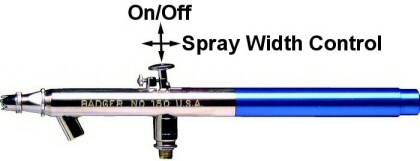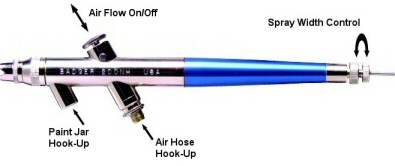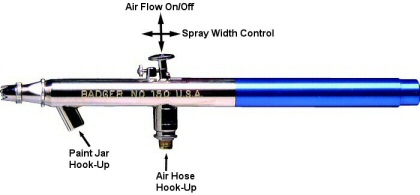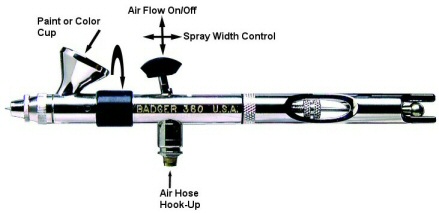Airbrush Types
Airbrushes are generally separated into two categories:
| Single-Action Airbrushes | Double-Action Airbrushes | |
 |  |
Single-Action:
The trigger only turns the air through the airbrush "on" or "off". The amount of paint or spray width is adjusted using a turning mechanism. On some models the tip (nozzle) is being screwed in our out, on other models the needle is moved back and forth using a turning mechanism. This means that one has to always test spray on a piece of scrap paper to adjust the desired spray width.

Advantages:
- Simple usage
- constant spray width
Disadvantages:
- When changing the spray width one has to spray on a piece of scrap paper
- Special Effects (e.g. spattering) can only be achieved using additional aids
Double-Action:
The trigger has two functions. Depressing the trigger will turn on the air through the airbrush. The amount of paint or spray width is adjusted through pulling back on the depressed trigger. That means one can continually adjust the spray width during spraying without having to stop. This double-action type of airbrush requires more practice and finger coordination.

Advantages:
- Spray width continuously adjustable
- Special Effects (e.g. spattering) can be achieved with any additional aids
Disadvantages::
- A certain spray width is more difficult to recreate at a later time
- Requires more practice and finger coordination.
With both types of airbrushes (single-action and double-action) there are also the following variations with respect to the paint supply:
| Gravity-Feed System | Siphon-Feed System | |
 |  |
The differences and advantages/disadvantages are explained below.
Gravity Feed Systems:
With gravity feed systems the paint is filled in a color cup on top of the airbrush and runs into the airbrush by itself (through gravity). That means one can work with a lower air pressure, since the paint only has to be blown out of the airbrush. Lower air pressure provides for a finer spray pattern and finer lines. Gravity feed airbrushes are often available with different size mounted color cups.
Areas of use:
This system is used when only small amounts of paint are needed. Three drops of paint are sufficient to cover the area equal to a finger nail. Additionally this system is used for very fine detail work (thinnest lines).
Advantages:
- Very fine lines can be sprayed
- Paint is not being wasted
- Since there is no paint jar hanging on the bottom of the airbrush it provides better balance in your hand
Disadvantages:
- When changing colors (e.g. red to green) one will have to clean the color cup on top of the airbrush. Just spraying out the nozzle with cleaner is not sufficient.
- Changing colors is a bit more involved and takes a little bit longer
- Color cup is usually open, paint can spill
Siphon System:
On siphon systems there is no color cup on top of the airbrush but a paint jar is hanging underneath the airbrush instead. This paint jar is connected to the airbrush through a tube. In order to get the paint from the paint jar up into the airbrush a vacuum of sufficient strength has to be created so paint can be sucked up into the airbrush. That means the air pressure has to be higher than with gravity feed systems. The paint does not simply need to be blown out of the airbrush but in addition must be sucked up into the airbrush. Air pressure must be high enough to generate sufficient vacuum at the nozzle. Because of the higher pressure the lines sprayed also tend to be slightly wider than they are with gravity feed systems. An older variation of a siphon feed airbrush is the side-feed system. The color jar or cup is attached on the right or left side of the airbrush. The principle of how it works is the same.
Areas of use:
This system is used when frequent color changes (e.g. red to green) are required or when larger areas are to be sprayed. The paint jar accepts quite a bit more paint than the small color cups on gravity feed systems. If free-hand lines equal to lines with a sharpened pencil are not required a siphon system airbrush is sufficient. In addition the paint jars are almost completely closed. If one is a bit clumsy (e.g. children) and tips over the paint jar or the airbrush, not all of the paint is spilled.
Advantages:
- Quick color change - remove paint jar, attach second paint jar with cleaner, spray until only cleaner comes out, attach jar with next color and continue your work
- Larger amounts of paint can be sprayed without having to stop and refill (larger areas in one go)
Disadvantages:
- In most cases will spray as fine detailed as a gravity system
- Airbrush is a bit heavy in the front due to the paint jar and the larger amount of paint
In essence the market offers the following four types of airbrushes:
 |  | |
| Single-Action/Gravity Feed | Single-Action/Siphon Feed | |
 |  | |
| Double-Action/Gravity Feed | Double-action/Siphon Feed |
Offered are single-action gravity feed systems (Badger 200-9), single-action siphon feed systems (Badger 200), double-action gravity feed systems (Badger 100 & Sotar), and double-action siphon feed systems (Badger 150, 155, 3155, 175).
In addition there are special models that combine the gravity feed and siphon feed systems in one airbrush. The front portion of the airbrush can usually be rotated on such airbrushes. That means the paint inlet of the airbrush can be rotated to either be on the top or the bottom and because of that the airbrush is both a siphon and gravity feed system (Badger 360).
 |
| Badger 360 (Color Cup rotated up) - Gravity-Feed System |
| |
 |
| Badger 360 (Color Cup rotated down) - Siphon-Feed System |
Another special model is a side-feed airbrush. With that airbrush type a color cup is mounted on the side of the airbrush. This color cup can be rotated and adjusted to the angle in which the airbrush is held. In addition this side-feed system does not obstruct the view as much of the object to be sprayed as would be the case with a gravity-feed airbrush.
| Badger 100 |
 |
| Side-Feed Airbrush |
Please also take a look at the document explaining the fundamental airbrush information and the Q&A section.






